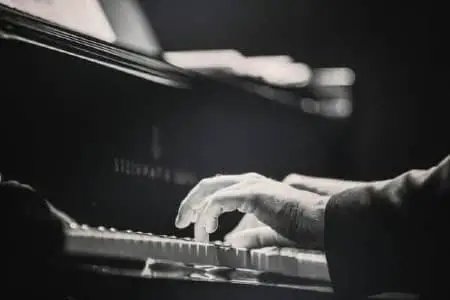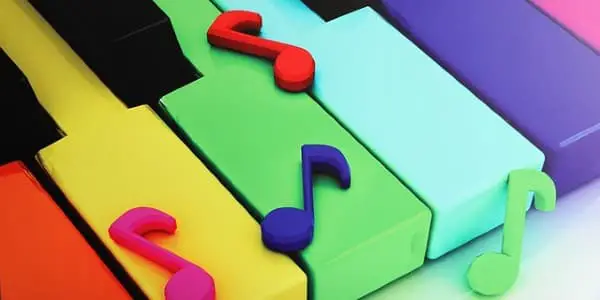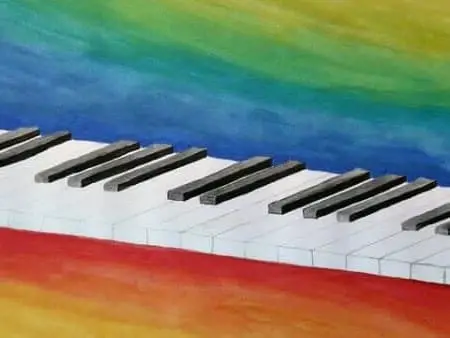- Home
- Piano Scales
- 12 Major Scales
Learn All 12 Major Scales for Piano
This article may contain compensated links. Please read the disclosure for more info.
In this piano lesson, you will learn and understand how to play all the 12 major scales on the piano in an easy way!
Follow the study guide, print the piano scales (PDF) with fingering, and get practice tips to learn how to play and practice all major scales in the most comfortable order.
12 Major Scales: 1 Formula
- Q: What do all the 12 major scales have in common?
- A: They all share the same pattern of whole and half steps!
Actually, there is only one major scale pattern, but it can be transposed (moved) to start from any note.
Of course, the scales don't visually look the same since each piano scale has its own specific pattern of black and white keys.
And you will need to adjust the fingering for some piano scales so they are comfortable to play. But quite a few scales actually share the same fingering, and these are also the easiest to begin with.
The not-so-secret formula for a major scale is all about the distance (interval) from one note to the next. From one note to the next there is either a whole step (tone) or a half step (semitone).
This specific pattern of intervals between each step in a major scale (ascending) is:
(any starting note)-whole-whole-half-whole-whole-whole-half.
That’s it! :)
Tip: A good piano scale book for beginners with all common piano scales, fingering and more, is: Basic Book of Scales, Chords and Arpeggios.
12 major piano scales study guide
After printing the scales below, here is your step by step guide on how to use them! Make sure to keep the scales handy as you follow along with this study guide.
Group 1 scales
The first seven of the 12 major scales all start on a white key. The first 5 of those use the same piano fingering patterns:
- Right hand: 123-1234 (5 for stopping and turning), and Left hand: (5) 4321-321.
Learning these first and really setting the fingering patterns makes it easier to learn the rest of the scales. Other tips:
- F and B major keep the basic fingering in one hand but has to change in the other.
- B major is by using all 5 black keys, also preparing you for the last scales in the second group.

1. The C major scale:
The C major scale is the only major scale without black keys, so it’s easy to start with. The fingering you learn will be used in the next 4 scales as well. So take time to learn it, it really pays back later!
2. The G major scale:
The G major scale has one black key, F#.
3. The D major scale:
The D major scale has two, F# and C#.
4. The A major scale:
An A major scale has three black keys, F#, C#, and G#.
5. The E major scale:
E major has four, F#, C#, G#, D#.
6. The F major scale:
And now for something different! The F major scale has one black key too, but this time it is a flat key, Bb. This Bb makes it necessary to change fingering in the right hand. The left hand uses the same fingering as before though.
7. The B major scale:
The B major scale includes all the black keys! It's actually the easiest of all the 12 major scales to learn in the right hand since it shapes your hand very nicely and makes it super easy to learn the fingering.(This is said to also be the first scale Chopin gave to his students to learn.)
However, the left hand has to change fingering from before, starting on finger 4.
Black Key Exercise
Before you start with the second group of piano scales, here's a clever little exercise for the scales using all five black keys:
- Play fingers 2 3 4 on the groups of three black keys, all over the piano.
- Play hands separately and together, parallel and contrary motion, whatever you like.
- Then fingers 2 3 on the groups of two black keys, and finally both groups.
The only things you will add later are the 2 “missing” white keys that will be played with the thumb most of the time.
Make sure to keep a good "cupped" hand posture, with lightly curved fingers playing on your fingertips.
Tip: If your 5th fingers stick out like antennae, make sure to relax your shoulders and arms all the way from the neck!
Group 2 scales
The second group of the 12 major scales consist of 5 scales that all start on a black key.
They could be called two names since the black keys have two names (for example C# or Db). The choice of one over the other has to do with how many sharps or flats they have in the key signature.
1. The Bb major scale:
Bb major has two black keys, Bb and Eb. Since it starts on a black key, the previous fingering has to be changed, as in all scales starting on a black key.
Why?
Well, for smooth playing, you have seen that we avoid using the thumb, or the first finger, on a black key when playing scales. The thumb is short and is better used to tuck under your palm for smooth lateral movements.
Start with finger 4 on Bb, and immediately tuck under the thumb on C. After that, the pattern is easy since the finger groups 1 2 3, and 1 2 3 4 each end on a black key.
The left hand will start directly with the finger groups 3 2 1 and 4 3 2 1 starting on a black key each time.
2. The Eb/D# major scale:
Eb major has three black keys, Bb, Eb, and Ab. The fingering changes again, but look for the finger groups, and it is easier to see the pattern.
Eb major could also be called D# major. These notes are enharmonic. This means that the two scales look, sound, and are played exactly the same on the keyboard but are written differently with notes.
3. The Db/C# major scale:
Db major has 4 black keys. Db major is enharmonic with C# major. It’s easier to use Db since it has fewer flats, 5, instead of C# that has 7 sharps.
4. The Ab/G# major scale:
Ab is very similar to B major if you look at what keys to use. The only difference is the two white keys!
5. The Gb/F# major scale:
Gb has five black keys, as before. See how the last 2 scales have so much in common with B major!
Free printable 12 major scales (pdf)
Make sure to follow the study guide above step by step, and you’ll be the Major Scale Master in no time! But start by printing your free 12 major scales (the links open in a new window):
Printable 12 Major Piano Scales (PDF):
Major Scales Group 1: 7 Scales Starting From a White Key (PDF)
Major Scales Group 2: 5 Scales Starting From a Black Key (PDF)
(Opens in a new window).
Some Final Advice
All scales are better to practice without notes. Playing by heart makes you more acquainted with each pattern on the keyboard and makes the topography of the piano keyboard much more familiar.
But as a reference, no pianist's library is complete without a scale book. A good reference piano scale book for beginners with all the common piano scales, fingering, and more is The Basic Book of Scales, Chords, and Arpeggios.









